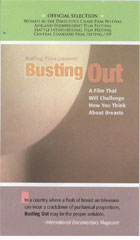
Busting Out 2004
Distributed by Bullfrog Films, PO Box 149, Oley, PA 19547; 800-543-FROG (3764)
Produced by Francine Strickwerda and Laurel Spellman Smith
Directed by Francine Strickwerda and Laurel Spellman Smith
VHS, color, 57 min.
College - Adult
Women's Studies, Gender Studies, American Studies, Psychology
Date Entered: 02/08/2006
ALA Notable: ALA.gif
Reviewed by Michelle Zafron, Health Sciences Library, University at Buffalo, State University of New York
Americans are obsessed with breasts, but why? That’s the question the filmmakers of Busting Out seek to answer. The breast serves a biological function and yet it is a source of attraction and arousal. Surgery either for cancer or to alter their appearance is commonplace. It’s an anatomical body part with multiple meanings in American culture.
In some ways, Busting Out is a film about contradictions. Even as one woman prepares to have her breasts augmented, we hear from a woman who wants them reduced—very much a case of “the grass is always greener.” The size of their breasts is connected to their notions of self-esteem and personal image. Co-director and writer Francine Strickwerda narrates the documentary. As a young girl, she lost her mother to breast cancer. Added to her tragedy, was a sense of shame with her developing body—an emotional reaction heard from others—both young and old.
There are a variety of interviews ranging from academics to radio shock jocks to women of all ages. Interestingly, American’s “breast-centric” attitude appears to be relatively rare in the world. A study done of 190 different subcultures throughout Africa and Asia found the breast an object of sexual import in only 13 of them. On a related note, we learn that the ideal breast size has gone up and down throughout the ages.
The two most substantive sections of the film deal with breastfeeding and breast cancer. Some of the experts posit that the American focus on breasts as erotic objects, combined with the baby formula industry’s aggressive marketing efforts have led to a reduction in American women breastfeeding. The segment on breast cancer includes interviews from breast cancer survivors and one woman facing a mastectomy. Again, the subject of industry’s involvement on the “marketing” in the battle against breast cancer arises.
The look of Busting Out is fresh and energizing. The filmmakers used a mix of interviews, 1950s educational films, and images from popular culture to great advantage. Busting Out also boasts an original score. Overall, the production values are excellent. The one fault of the documentary is that its short running time does not allow it enough time to address the many, many questions it raises in any meaningful way. It might have been more productive for the filmmakers to focus in on a handful of these. However, Busting Out is a documentary filled with insight and humor. It is recommended and would make an excellent starting point for discussion in a number of different contexts including gender studies, American studies, women’s studies, and psychology.